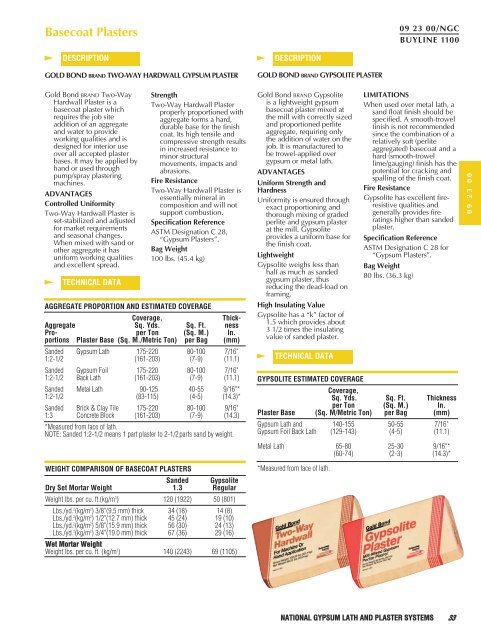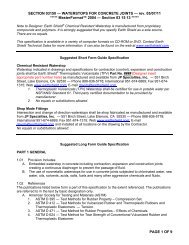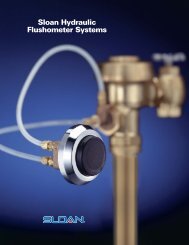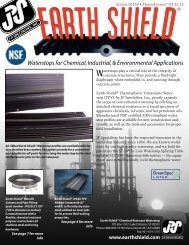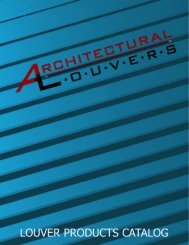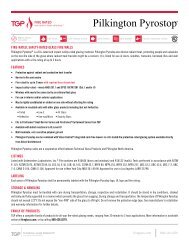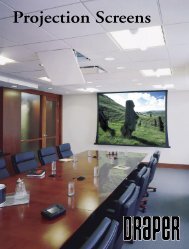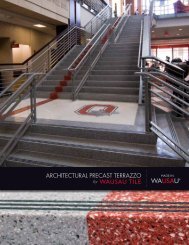National Gypsum Construction Guide
National Gypsum Construction Guide The entire - AECinfo.com
National Gypsum Construction Guide The entire - AECinfo.com
- No tags were found...
You also want an ePaper? Increase the reach of your titles
YUMPU automatically turns print PDFs into web optimized ePapers that Google loves.
Basecoat Plasters<br />
09 23 00/NGC<br />
BUYLINE 1100<br />
DESCRIPTION<br />
GOLD BOND BRAND TWO-WAY HARDWALL GYPSUM PLASTER<br />
DESCRIPTION<br />
GOLD BOND BRAND GYPSOLITE PLASTER<br />
Gold Bond BRAND Two-Way<br />
Hardwall Plaster is a<br />
basecoat plaster which<br />
requires the job site<br />
addition of an aggregate<br />
and water to provide<br />
working qualities and is<br />
designed for interior use<br />
over all accepted plaster<br />
bases. It may be applied by<br />
hand or used through<br />
pump/spray plastering<br />
machines.<br />
ADVANTAGES<br />
Controlled Uniformity<br />
Two-Way Hardwall Plaster is<br />
set-stabilized and adjusted<br />
for market requirements<br />
and seasonal changes.<br />
When mixed with sand or<br />
other aggregate it has<br />
uniform working qualities<br />
and excellent spread.<br />
TECHNICAL DATA<br />
Strength<br />
Two-Way Hardwall Plaster<br />
properly proportioned with<br />
aggregate forms a hard,<br />
durable base for the finish<br />
coat. Its high tensile and<br />
compressive strength results<br />
in increased resistance to<br />
minor structural<br />
movements, impacts and<br />
abrasions.<br />
Fire Resistance<br />
Two-Way Hardwall Plaster is<br />
essentially mineral in<br />
composition and will not<br />
support combustion.<br />
Specification Reference<br />
ASTM Designation C 28,<br />
“<strong>Gypsum</strong> Plasters”.<br />
Bag Weight<br />
100 lbs. (45.4 kg)<br />
AGGREGATE PROPORTION AND ESTIMATED COVERAGE<br />
Coverage,<br />
Thick-<br />
Aggregate Sq. Yds. Sq. Ft. ness<br />
Pro- per Ton (Sq. M.) In.<br />
portions Plaster Base (Sq. M./Metric Ton) per Bag (mm)<br />
Sanded <strong>Gypsum</strong> Lath 175-220 80-100 7/16"<br />
1:2-1/2 (161-203) (7-9) (11.1)<br />
Sanded <strong>Gypsum</strong> Foil 175-220 80-100 7/16"<br />
1:2-1/2 Back Lath (161-203) (7-9) (11.1)<br />
Sanded Metal Lath 90-125 40-55 9/16"*<br />
1:2-1/2 (83-115) (4-5) (14.3)*<br />
Sanded Brick & Clay Tile 175-220 80-100 9/16"<br />
1:3 Concrete Block (161-203) (7-9) (14.3)<br />
*Measured from face of lath.<br />
NOTE: Sanded 1:2-1/2 means 1 part plaster to 2-1/2parts sand by weight.<br />
Gold Bond BRAND Gypsolite<br />
is a lightweight gypsum<br />
basecoat plaster mixed at<br />
the mill with correctly sized<br />
and proportioned perlite<br />
aggregate, requiring only<br />
the addition of water on the<br />
job. It is manufactured to<br />
be trowel-applied over<br />
gypsum or metal lath.<br />
ADVANTAGES<br />
Uniform Strength and<br />
Hardness<br />
Uniformity is ensured through<br />
exact proportioning and<br />
thorough mixing of graded<br />
perlite and gypsum plaster<br />
at the mill. Gypsolite<br />
provides a uniform base for<br />
the finish coat.<br />
Lightweight<br />
Gypsolite weighs less than<br />
half as much as sanded<br />
gypsum plaster, thus<br />
reducing the dead-load on<br />
framing.<br />
High Insulating Value<br />
Gypsolite has a “k” factor of<br />
1.5 which provides about<br />
3 1/2 times the insulating<br />
value of sanded plaster.<br />
TECHNICAL DATA<br />
LIMITATIONS<br />
When used over metal lath, a<br />
sand float finish should be<br />
specified. A smooth-trowel<br />
finish is not recommended<br />
since the combination of a<br />
relatively soft (perlite<br />
aggregated) basecoat and a<br />
hard (smooth-trowel<br />
lime/gauging) finish has the<br />
potential for cracking and<br />
spalling of the finish coat.<br />
Fire Resistance<br />
Gypsolite has excellent fireresistive<br />
qualities and<br />
generally provides fire<br />
ratings higher than sanded<br />
plaster.<br />
Specification Reference<br />
ASTM Designation C 28 for<br />
“<strong>Gypsum</strong> Plasters”.<br />
Bag Weight<br />
80 lbs. (36.3 kg)<br />
GYPSOLITE ESTIMATED COVERAGE<br />
Coverage,<br />
Sq. Yds. Sq. Ft. Thickness<br />
per Ton (Sq. M.) In.<br />
Plaster Base (Sq. M/Metric Ton) per Bag (mm)<br />
<strong>Gypsum</strong> Lath and 140-155 50-55 7/16"<br />
<strong>Gypsum</strong> Foil Back Lath (129-143) (4-5) (11.1)<br />
Metal Lath 65-80 25-30 9/16"*<br />
(60-74) (2-3) (14.3)*<br />
09 23 00<br />
WEIGHT COMPARISON OF BASECOAT PLASTERS<br />
Sanded Gypsolite<br />
Dry Set Mortar Weight 1.3 Regular<br />
Weight lbs. per cu. ft.(kg/m 3 ) 120 (1922) 50 (801)<br />
Lbs./yd. 2 (kg/m 2 ) 3/8"(9.5 mm) thick 34 (18) 14 (8)<br />
Lbs./yd. 2 (kg/m 2 ) 1/2"(12.7 mm) thick 45 (24) 19 (10)<br />
Lbs./yd. 2 (kg/m 2 ) 5/8"(15.9 mm) thick 56 (30) 24 (13)<br />
Lbs./yd. 2 (kg/m 2 ) 3/4"(19.0 mm) thick 67 (36) 29 (16)<br />
Wet Mortar Weight<br />
Weight lbs. per cu. ft. (kg/m 3 ) 140 (2243) 69 (1105)<br />
*Measured from face of lath.<br />
NATIONAL GYPSUM LATH AND PLASTER SYSTEMS<br />
33


